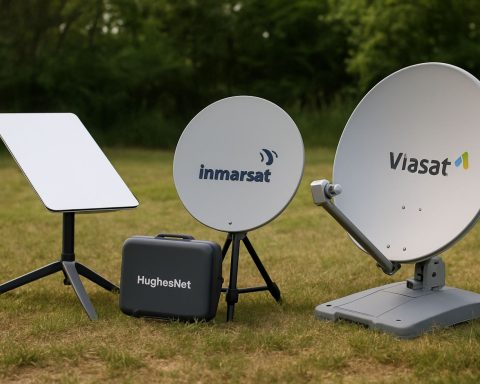- Nvidia’s revenue soared to $130.5 billion in 2025, a 114% increase year over year, yet its stock has fallen by 14% due to market skepticism.
- Geopolitical tensions and AI export controls to China pose significant challenges, impacting Nvidia’s market share and manufacturing costs.
- Despite obstacles, Nvidia’s commitment to AI is strong, highlighted by the launch of its Blackwell architecture and significant product revenues.
- The AI inferencing market is projected to grow to $255 billion by 2030, and Nvidia’s GB200 chips are key players in this expansion.
- Nvidia’s history of overcoming financial downturns underscores its resilience and strategic adaptability.
- Investors are advised to remain patient; a strategy of dollar-cost averaging may leverage Nvidia’s long-term growth potential amidst market volatility.
Beneath Silicon Valley’s technological canopy, Nvidia emerges as a pioneer, wielding its prowess in the artificial intelligence domain. The fiscal landscape for Nvidia in 2025 revealed a robust tableau, with revenues catapulting to $130.5 billion, marking a meteoric 114% leap year over year. Despite such financial acrobatics, the market has cast a skeptical gaze, trimming Nvidia’s stock by 14% since the earnings disclosure in February.
Investors are now at the crossroads: Is this a fleeting stumble or a signal to steer clear? The swirling economic winds, marked by geopolitical tensions and escalating tech sector uncertainty, underscore Nvidia’s current predicament. The Biden administration’s planned “AI Diffusion” controls threaten to hamstring Nvidia’s exports to China, a market where its foothold has already halved. Further, looming tariffs from the earlier era of trade skirmishes risk inflating manufacturing costs and jarring Nvidia’s finely tuned supply chains.
Despite these turbulences, Nvidia’s resolve to dominate in AI remains unshaken. Its new Blackwell architecture stands as a testament to its ambition, achieving the most rapid product launch in the company’s history and contributing a staggering $11 billion in recent quarterly revenue. The tech powerhouse sets its sights on the AI inferencing market, projected to expand from $106 billion to $255 billion by 2030. Nvidia’s groundbreaking GB200 chips are sharpening their claws on this burgeoning battlefield, purpose-built for the demanding “reasoning AI” workloads revealed by models like OpenAI’s o3 and DeepSeek-R1. These advanced tasks, requiring a hundredfold increase in computing might, position Nvidia at the pinnacle of AI innovation, offering advanced performance at a fraction of the historical costs.
Moreover, the theory of Jevons Paradox shines a light on Nvidia’s strategic moves. As AI systems grow more resource and cost-efficient, accessibility to AI increases, spurring widespread adoption and, paradoxically, driving even greater demand for AI infrastructure. With foundational models evolving, Nvidia stands to harness this demand wave within emerging verticals—ranging from autonomous vehicles to robotics and sovereign AI.
Historically, Nvidia has weathered financial storms with resilience. Market recalls are not new: The 2018 crypto crunch led a dramatic stock plunge, the COVID-19 downturn tested investor faith, and concerns over diminished AI expenditure triggered short-term wariness in 2024. Yet, history echoes a consistent narrative—Nvidia rebounds robustly, spearheading corrections with decisive strategic pivots and capitalizing on renewed opportunities.
For wary investors, the roadmap is clear: while Nvidia’s stock weaves through market tempests, patience—not panic—might well serve as the most prudent compass. A strategy rooted in dollar-cost averaging may pare risks while positioning investors to gain from Nvidia’s long-term trajectory. The broader technological landscape warrants vigilance, but history suggests Nvidia’s innovation-led charge is far from running its course. As AI continues to sculpt the digital frontier, Nvidia’s saga is poised to become one of the industry’s enduring success stories.
Is Nvidia a Safe Bet Amid Stock Market Volatility? A Closer Look
Financial Performance and Market Context
Nvidia’s impressive financial performance in 2025, with revenues soaring to $130.5 billion, underscores its leading role in the AI sector. Despite this growth, Nvidia’s stock faced a 14% decline, partly due to market skepticism amid geopolitical tensions and tech sector uncertainties. For investors, this presents a critical question: Is now the time to buy, hold, or sell Nvidia stock?
Geopolitical Challenges
Investment in Nvidia must consider geopolitical factors. The U.S. government’s “AI Diffusion” controls potentially hinder Nvidia’s exports to China, severely impacting a market that already accounts for a significant portion of its revenue. Coupled with tariffs and supply chain disruptions from previous trade disputes, Nvidia faces increased production costs.
Technological Innovations
Nvidia’s Blackwell architecture and GB200 chips demonstrate the company’s relentless innovation, targeting the expanding AI inferencing market. This market is expected to grow to $255 billion by 2030, with Nvidia uniquely positioned to capitalize on this surge. As AI infrastructures broaden, Jevons Paradox signals that increased efficiency could lead to higher demand, potentially benefiting Nvidia’s growth.
Market Forecasts & Industry Trends
1. AI Inferencing Market Growth: Projected to reach $255 billion by 2030, offering a robust opportunity for Nvidia.
2. Autonomous Systems Expansion: With autonomous vehicles and Robotics, Nvidia targets emergent markets as foundational AI models advance.
3. Sovereign AI Development: Nvidia equips emerging sectors with the necessary hardware to handle sophisticated reasoning AI workloads.
Reviews & Comparisons
When compared to its competitors, Nvidia’s cutting-edge technology and historical resilience make it a formidable player in the AI and tech arenas. For example, competitors like Intel and AMD may struggle to match Nvidia’s advanced product launches and integration into AI markets.
Controversies & Limitations
Challenges include dependence on volatile global markets and regulatory environments. Additionally, Nvidia needs to navigate the balance between rapid product development and consistent quality assurance amidst complex AI infrastructure demands.
Strategic Recommendations
– Investment Strategy: Consider a dollar-cost averaging approach to mitigate risks associated with shared price volatility. This involves regular, small investments regardless of stock price fluctuations.
– Diversification: Balance Nvidia investments with those in a mix of tech and non-tech stocks to stabilize your portfolio.
– Stay Informed: Keep track of geopolitical developments and Nvidia’s strategic pivots to make informed decisions.
Pros & Cons Overview
Pros
– Leader in a fast-growing AI market.
– Strong history of financial resilience and innovation.
– Dominant position in emerging AI applications.
Cons
– Geopolitical and regulatory risks affecting revenue, especially in China.
– Stock price volatility despite robust earnings.
– Potential for increased manufacturing costs due to tariffs.
Conclusion
Nvidia’s future looks promising if it can successfully navigate geopolitical hurdles and continue its legacy of innovation. Investors should remain patient and strategic, recognizing that Nvidia has consistently rebounded from past challenges and is positioned to ride the wave of AI infrastructure demand. Whether you’re considering investing or holding onto your shares, monitor the broader tech and geopolitical landscapes for the most informed decisions.
For more insights into technological advancements and investment strategies in the AI sector, visit Nvidia’s official site.









